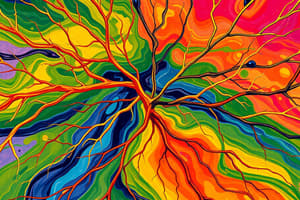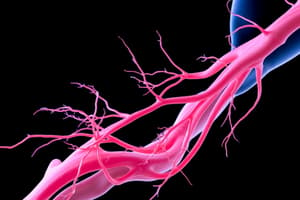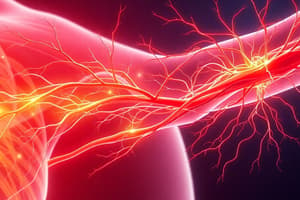Podcast
Questions and Answers
What is the peripheral nervous system?
What is the peripheral nervous system?
Nervous tissue outside the vertebral canal and brainstem that connects the body to the central nervous system.
Which of the following is part of the peripheral nervous system? (Select all that apply)
Which of the following is part of the peripheral nervous system? (Select all that apply)
- Vertebral Canal
- Spinal Nerves (correct)
- Brainstem
- Cranial Nerves (correct)
How many cervical nerves are there?
How many cervical nerves are there?
- 4
- 5
- 12
- 8 (correct)
What is formed from the anterior rami of the spinal nerves?
What is formed from the anterior rami of the spinal nerves?
Which plexus is responsible for the muscles of the upper limb?
Which plexus is responsible for the muscles of the upper limb?
What are the divisions formed by the trunks of the brachial plexus?
What are the divisions formed by the trunks of the brachial plexus?
The lateral cord of the brachial plexus primarily supplies muscles of the posterior compartments.
The lateral cord of the brachial plexus primarily supplies muscles of the posterior compartments.
Which nerve innervates the deltoid muscle?
Which nerve innervates the deltoid muscle?
What is Erb's Palsy associated with?
What is Erb's Palsy associated with?
What syndrome involves immediate burning or paralysis radiating from the neck?
What syndrome involves immediate burning or paralysis radiating from the neck?
Flashcards are hidden until you start studying
Study Notes
Peripheral Nervous System Overview
- Peripheral Nervous System (PNS) consists of all nervous tissue outside the vertebral canal and brainstem.
- Connects the body to the Central Nervous System (CNS).
- Comprised of Cranial Nerves and Spinal Nerves (8 Cervical, 12 Thoracic, 5 Lumbar, 5 Sacral, 1 Coccygeal).
Plexus Formation
- Anterior rami of spinal nerves join to form networks known as plexuses (except thoracic nerves).
- Major plexuses include:
- Cervical Plexus (C1-C4) for neck muscles.
- Brachial Plexus (C5-T1) for upper limb muscles.
- Lumbosacral Plexus (L1-S5) for lower limb muscles.
Cervical Plexus
- Formed from anterior rami C1-C4.
- Key branches:
- C2: Sternocleidomastoid.
- C3 & C4: Trapezius.
- C3-C5: Levator Scapulae.
- C4: Anterior Scalene.
- C3-C4: Middle Scalene.
- C3-C5: Phrenic Nerve (innervates diaphragm).
Brachial Plexus Structure
- Formed from anterior rami of C5-T1 spinal nerves.
- Splits and reunites several times into a complex structure.
- Comprises:
- 5 Roots (C5, C6, C7, C8, T1).
- 3 Trunks (Superior, Middle, Inferior).
- 6 Divisions (anterior and posterior).
- 3 Cords (Lateral, Medial, Posterior).
- 5 Branches (Musculocutaneous, Axillary, Radial, Median, Ulnar).
Brachial Plexus Pathway
- Located between the anterior scalene and middle scalene muscles, adjacent to the subclavian artery and vein.
- Direct branches arise from roots:
- Dorsal Scapular Nerve (C5) innervates rhomboids and levator scapulae.
- Long Thoracic Nerve (C5, C6, C7) innervates serratus anterior.
Trunks of Brachial Plexus
- Superior Trunk (C5-C6).
- Middle Trunk (C7).
- Inferior Trunk (C8-T1).
- Key nerves from the Superior Trunk:
- Suprascapular Nerve (innervates supraspinatus and infraspinatus).
- Subclavius Nerve (innervates subclavius).
Cords of Brachial Plexus
- Named based on their position relative to the axillary artery.
- Lateral Cord:
- Lateral Pectoral Nerve innervates pectoralis major.
- Medial Cord:
- Medial Pectoral Nerve innervates pectoralis major and minor.
- Posterior Cord:
- Upper Subscapular Nerve (innervates subscapularis).
- Thoracodorsal Nerve (innervates latissimus dorsi).
- Lower Subscapular Nerve (innervates subscapularis and teres major).
Terminal Branches of Brachial Plexus
- Musculocutaneous Nerve: Innervates biceps brachii, brachialis, and coracobrachialis.
- Axillary Nerve: Innervates deltoid and teres minor.
- Radial Nerve: Innervates triceps, anconeus, brachioradialis, supinator, and 10 other muscles.
- Median Nerve: Innervates pronator teres, pronator quadratus, and 9 additional muscles.
- Ulnar Nerve: Innervates 11 muscles.
Common Pathologies of Peripheral Nerves
- Neuropathy: Neurological deficits along a nerve pathway.
- Brachial Plexus Pathologies:
- Thoracic Outlet Syndrome (TOS): Compromised nerves between the clavicle and first rib.
- Burner/Stinger Syndrome: Immediate burning or paralysis caused by stretching the nerve after a blow to the head or shoulder.
Pathologies Specific to Brachial Plexus
- Scapular Winging: Associated with weakness or paralysis of serratus anterior due to long thoracic nerve injury.
- Erb's Palsy: Upper trunk injury (C5-C6), characterized by "waiter's tip" position; affects musculocutaneous, axillary, dorsal scapular, and suprascapular nerves.
- Klumpke’s Palsy: Lower trunk injury (C8, T1) affecting the ulnar, medial pectoral, and thoracodorsal nerves.
Studying That Suits You
Use AI to generate personalized quizzes and flashcards to suit your learning preferences.




